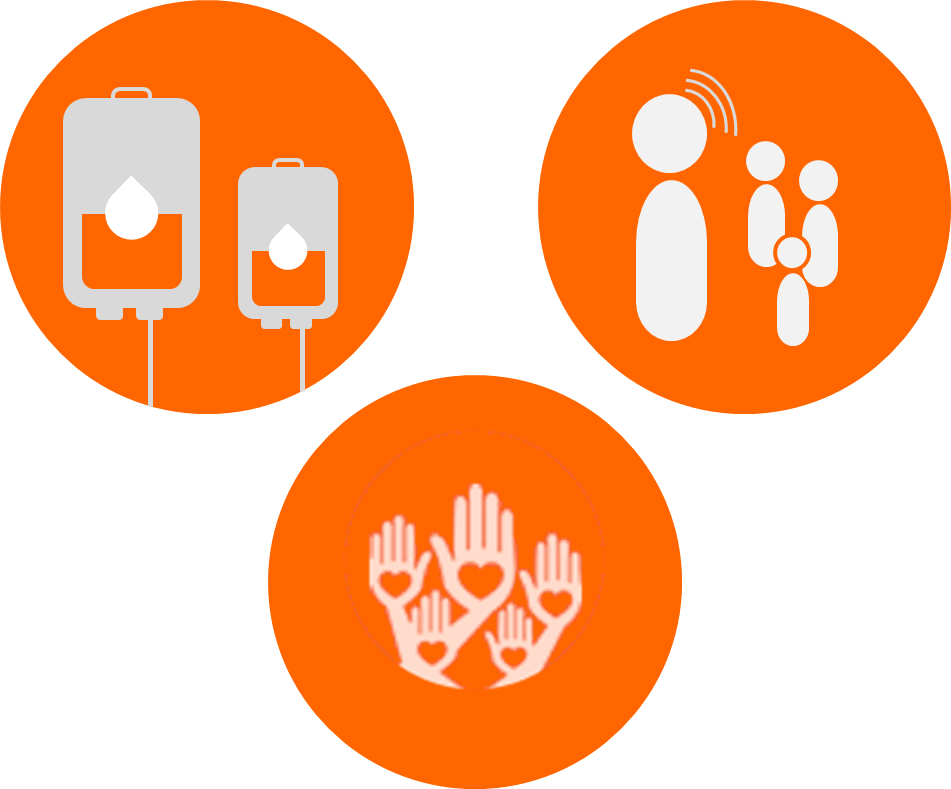
Would you like to start a conversation with other industry leaders to brainstorm a challenge or to just know more on a particular topic?
Engage in online discussions with your Peers
Start NowBusiness Process Management (BPM) does not apply to the business arena alone. The discipline, rigour, efficiency and effectiveness that fundamentally underpin BPM are equally applicable to areas outside of business. In other words, BPM techniques are as relevant in a social environment as in a business environment. This article examines applying a step-by-step approach for a socio-medical cause in the not-for-profit sector – the cause of blood stem cell donation as a cure for blood disorders.
 Blood cancer is curable. It is NOT a death sentence! There are about 100 blood related disorders that are curable. Many of these affect children and young adults. They can affect anybody, without warning. They are serious disorders, but they can be cured.
Blood cancer is curable. It is NOT a death sentence! There are about 100 blood related disorders that are curable. Many of these affect children and young adults. They can affect anybody, without warning. They are serious disorders, but they can be cured.
They can be cured through a blood stem cell transplant from a matched donor. The trouble lies in finding a matched donor. Just like in a blood transfusion, the blood group (ABO) has to match, in the case of blood stem cell transplant, the “HLA type” has to match. A patient has only a 25% chance of finding a match from within the family. Therefore, most patients have to look for an unrelated donor and here the probabilities of a match are anywhere from 1 in 10,000 to 1 in 2 million. Largely due to very little awareness of blood stem cell donation in India, patients can’t be cured through a stem cell transplant, simply because it is extremely difficult to find a genetically matched donor.
DATRI Blood Stem Cell Donors’ Registry was set up in 2009, as a not-for-profit company to spread awareness about blood stem cell donation, to register volunteer donors and to help patients who are in need of a donor to find a match. DATRI is a member of the World Marrow Donor Association (WMDA) as well as of a global network of donor registries, Bone Marrow Donors Worldwide (BMDW).
The main activities of DATRI are to spread awareness, to do donor registration drives and to register potential donors purely on a voluntary basis. A key segment of their volunteers comes from people working in companies, especially in the IT & BPO sector. In this sector there are usually large numbers of young people who would be ideal donors, if they are well informed and are willing to donate. The process of identifying a company and conducting a blood stem cell donor registration drive is akin to any other business process.
There are four steps to running a donor registration drive in any company:
- Obtaining the company’s permission to conduct a drive
- Intensive communication to employees prior to the drive
- Conducting the drive on a given day or set of days and registering potential donors
- Maintaining the registry of potential donors and finding a match for a needy patient
‘Recruiting’ the company
This is often the most difficult phase of the process as most companies, being focused on their business, are not normally attuned to such causes. CSR departments or occasionally HR departments handle requests of support for social causes and are more used to donating money rather than activities of this nature. Therefore “drive development” has to be undertaken, similar to business development at BPM companies.
The process by which this is done is very similar to industrial selling. Contacts are activated with senior managers in organizations, presentations are made, follow-up done, questions answered, and the company is “recruited” for the drive. Standard CRM type processes are instituted. And, as in any typical sales scenario, there are wins and losses – the only difference being that losses are not to competition, but to inaction.
Communication
Once a company has been “won”, an intense communication exercise to employees is planned and executed. This consists of the following steps:
-
Targeted emails from senior management in the company to all the employees. This follows a teaser campaign routine – a mail a day in the week prior to the drive teasing and introducing the cause.
-
Posters, banners and physical props are widely disseminated in the office to catch the eye of employees.
-
A video is played two days before the drive at screens in the company and circulated to WhatsApp Groups amongst employee teams.
-
A floor walk on the day of the drive, whereby a DATRI employee does 10 minute floor huddles in each team explaining the cause, appealing to employees’ human instincts, detailing the safety and ease of the registration and donation process, and seeking their support.
Over time and experience, DATRI has fine-tuned this process such that these are conducted with standard levels of delivery and effectiveness across the country. Based on the effectiveness of communication, a targeted registration number is fixed – usually between 10-30% of the employee strength.

Conducting the Drive
On the scheduled day, the drive is conducted with the highest amount of efficiency possible and minimizing the demands on the employees’ time. This is achieved through the following standardized steps:
-
Registration Desks are set up in such a manner so as to make it as easy for employees to register. In large companies, a registration desk is set up on every floor or wing. In smaller companies they are set up in a public place – usually the cafeteria or reception.
-
Desks are managed both by DATRI employees as well as volunteers from the company. The company volunteers become DATRI’s ambassadors.
-
Registration forms are made easily available and filling up a form takes 2-3 minutes
-
A buccal swab (a cheek swab) is collected to get the potential donor’s HLA type. This takes less than 10 seconds.
-
Barcodes are affixed to the forms and the buccal swab. A bar coded donor registration card is given to the registering employee.
-
The whole process takes less than 5 minutes.
By allowing DATRI to do these drives, companies do not undertake any responsibility for any donation or have any liability whatsoever.
They are just giving an opportunity for employees to make a personal, voluntary decision and register as an individual and not as an employee of the company.
The process of registration as outlined above is non-intrusive, does not take more than 5 minutes for any employee and does not disrupt the company’s normal activities. It can be done with minimum effort and with no financial expenditure.
Post the Drive
After the drive is over, the registration forms are entered into a database, similar to a standard BPO process of data entry. Because of the need for physical signatures, this process remains manual and data is entered manually rather than being automated. In due course, just as in any other BPM optimization, this too will get automated.
The swabs are sent to the lab for testing and determination of the HLA type. This data is stored in a separate database with the common link being the barcode number. This ensures complete data privacy, usually a concern for companies.
Process improvements are continuous and rapid. For instance, updating and cleaning the donor database is critical. A donor may become a match for somebody several years after registration. Keeping contact details up-to-date and the database as live as possible is a major area of focus.
Doctors treating their patients can send in request for a donor by sharing the patient’s HLA type with the registry. DATRI will carry out a detailed database search to find out if there is a matched donor. If one is found, DATRI will facilitate the actual donation by connecting with the donor based on the contact information available on the database while keeping the confidentiality of both the patient and the donor.
DATRI needs your help
Readers of this publication are captains of industry. You are in a position to influence what your company does. DATRI needs your help to open the doors of your company to conduct blood stem cell donor registration camps. This enables not only saving many lives, but also inculcates a spirit of volunteering in employees, a culture of giving and empathy for social causes. All of these are excellent HR outcomes that benefit a company.
Application of BPM techniques in the social space
The term ‘business’ in the BPM nomenclature is a reference point. Good ‘process management’ is applicable anywhere a structured step-by-step approach is involved and usually is more of a need in the social sector where emotions often trump efficiency. As can be noted, by applying the principles of BPM, DATRI is attempting to succeed better in what is purely a social cause – the cause of spreading awareness amongst Indians, of registering large numbers of potential blood stem cell donors and achieving the mission of a global society in which every patient in need of life saving blood stem cells, is provided with an opportunity to find a genetically matched, willing donor.
Please contact us if you wish to be a part of this life-saving cause.
One awareness campaign could change the lives of many waiting in hope for their saviour.
Tel: +91 44 22541283, 44 40795300
E-Mail: info@datri.org, Website: www.datri.org
Subscribe to DATRI’s YouTube Channel: https://www.youtube.com/channel/UCcJoKLreGBiOjynohpEuBig
Like DATRI on Facebook: https://www.facebook.com/datriworld
ABOUT THE AUTHOR

Ramesh has 28 years of global industry experience. He started his career with Unilever and worked with them in India and in the UK for over 20 years. During his association with Unilever, he set up Indigo, the shared services subsidiary for Unilever and led its development globally. When Unilever sold the business, he oversaw the transition of Indigo to Capgemini. In Capgemini, he led the BPO business for Asia and was a member of the global BPO Board. During this period he lived and worked in China and led a 4000 member team across India, China and Australia. Ramesh has global experience in the consumer goods and outsourcing industries in over 20 countries across Europe, Asia, Africa and North America. Ramesh is a Management post graduate from the Indian Institute of Management, Ahmedabad.




